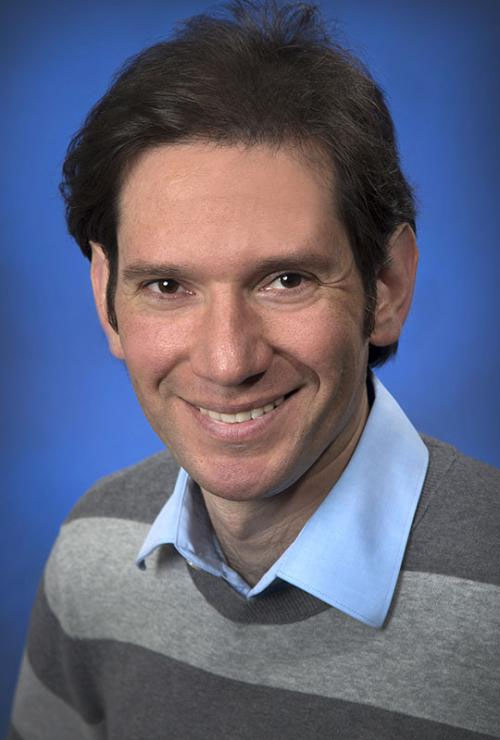SEED Grants 2020
Developing Methods for Understanding Chemical Kinetics on Surfaces
| Mónica Bugallo SBU, Electical and Computer Engineering Anibal Boscoboinik BNL, Center for Functional Nanomaterials |
 Mónica Bugallo |
 Anibal Boscoboinik |
This interdisciplinary project aims at developing novel strategies for understanding the kinetics of surface reactions. The Seed funding will result in advances in methodology and data analytics, ultimately leading to an improved mechanistic understanding of heterogeneously catalyzed reactions. The cutting-edge facilities used in this project, coupled with the new methodologies to be developed will also result in unique capabilities for in-situ studies of surface kinetics in general, attracting the wider user community in the field to adopt these developments.
Software Assist for Hardware-Managed Virtual Memory on FPGA Accelerators
| Michael Ferdman SBU, Computer Science Lingda Li BNL, Computational Science Initiative |
 Michael Ferdman |
 Lingda Li |
Nearly all fields of science now rely heavily on high-performance computing (HPC), constantly demanding greater computational capabilities. This unending thirst for compute has driven a rapid expansion of heterogeneous computing, where traditional CPUs are augmented with specialized "accelerators" that are able to perform computation faster. Today, practically all HPC machines include GPUs, accelerators specialized for bulk matrix multiplication. As CPUs execute the application, they can farm out matrix computation to GPUs. However, although GPUs are extremely effective for matrix operations, many emerging applications include computational patterns that are not amenable to GPU acceleration.
This proposal targets an emerging class of accelerators called FPGAs (Field-Programmable Gate Arrays). FPGAs have gained popularity in the past several years, with FPGA cards becoming readily available and major cloud providers such as Amazon EC2 and Microsoft Azure renting servers equipped with FPGAs. Although FPGAs lag behind GPUs when handling matrix operations, FPGAs offer massive acceleration opportunities for emerging “irregular” applications such as graph processing and sampling.
One of the most crucial aspects for developing software that uses accelerators is the mechanism of sharing data between the CPU and the accelerator. Traditionally, software developers were required to manually orchestrate all data movement between the CPU and accelerators; although effective, this manual approach is painstaking and error-prone. As a result of many years of tool development, techniques now exist to alleviate this burden and allow systems to automatically handle data movement for GPUs. This proposal will combine the PIs’ expertise to develop mechanisms that automatically handle data movement between the CPU and FPGA accelerators, easing the development of software and adoption of systems with FPGA accelerators.
Development of Novel Ligands for Radioarsenic Complexation
| Wenchao Qu SBU, Department of Psychiatry, School of Medicine Vanessa A. Sanders BNL,Medical Isotope Research and Production Program |
 Wenchao Qu |
 Vanessa A. Sanders |
Radiopharmaceuticals have been used extensively as diagnostic and therapeutic agents in nuclear medicine. Recently the field has seen an expansion following major advancements in imaging modalities and the production of novel isotopes. Driving this growth has been a new class of agents known as theragnostics. These agents utilize diagnostic isotopes to inform a patient’s treatment strategy and radiation dose with a therapeutic agent. The Brookhaven Linac Isotope Producer (BLIP) at Brookhaven National Laboratory (BNL) has been crucial to producing necessary isotopes for clinical institutions in the United States for several decades. One of the isotopes of interest that can be routinely produced using the BLIP is arsenic-72 (72As). This potential positron emission tomography (PET) imaging radionuclide has a physical half-life of 26 hours, which matches well with the biological half-lives of large biomolecules such as antibodies and peptides. Another arsenic isotope of interest is arsenic-77, a beta emitting (βmax= 0.683 MeV) therapeutic radionuclides with a half-life of 38 hours. Utilizing 72As as a diagnostic agent and 77As as a therapeutic agent embodies the theragnostic treatment strategy. There has been an ongoing effort to design ligand systems that form highly stable complexes with As(III) and allow for facile conjugation of biological targeting vectors. However, radiolabeling of antibodies with current tridentate chelate systems has been particularly challenging. Radiopharmaceuticals incorporated with 72,77As(III) require high stability in order to maintain their efficacy in vivo. The coordination chemistry of As(III) to polydentate ligands bearing NS3 or N3S3 donor sets is quite promising and has potential to increase in vivo stability. The aim of this proposal is to investigate the use of tetra- and hexadentate aminothiolate ligands as alternative chelators for 72,77As(III). The coordination chemistry of other novel Group 15 radionuclides, such as antimony, will also be evaluated with the aminothiolate chelators proposed for arsenic.
Upgrading Nuclear Safety Requirements to Prevent Technological Catastrophes
| Stan Uryasev SBU, Applied Mathematics and Statistics Pranab Samanta BNL, Reactor Systems & Risk Analysis Group |
 Stan Uryasev |
 Pranab Samanta |
Why existing safety requirements or regulations do not prevent technological catastrophes with extremely large losses in various engineering areas? A simple, and to some extent surprising answer, is that the safety requirements are focused toward likely accidents and consequences and are not necessarily designed to prevent major catastrophes with extremely large outcomes.
The safety goals in a majority of engineering fields are usually probabilistically designed and are not necessarily focused to control the magnitude of very large outcomes. Some thresholds (lower bounds) are specified that should be exceeded with a very low probability. For instance, in nuclear safety, a level of release of radiation in the environment is specified, which may be exceeded, say, only once in 10,000 years. Nevertheless, the magnitude of exceedance is not directly controlled for extremely large outcomes. Safety regulations do not distinguish the magnitude of outcomes exceeding a highest threshold corresponding to a major accident. For instance, one can argue that safety requirements were not violated in the Fukushima nuclear accident. We can verify calculations of safety models for the Fukushima nuclear power plant and come to a conclusion that the nuclear plant safety system worked as designed (no violation because the probability of radiation release is low, in spite of a very large magnitude of the release, which is not controlled). Similar concerns arise in certification of materials (A/B basis), etc. Addressing magnitude of large outcomes in defining regulations of complex technological systems will be a useful addition to the existing regulations in consideration of public health and safety.
This project suggests improvement in risk management and control of extremely large losses in engineering systems. The approach is based on the new risk measure, Buffered Probability of Exceedance (bPOE), which will supplement regulations based on Probability of Exceedance (POE). bPOE is the probability of outcomes in the tail of the distribution with the known mean value of the tail, in contrast to POE, which is the probability of the tail with the known lowerbound of the tail. POE, which is the current standard in safety evaluations, does not account for the magnitude of losses in the tail, while bPOE considers the average value of tail outcomes.
Characterizing structural states in NMDA receptors
| Lonnie Wollmuth SBU, Neurobiology and Behavior, School of Medicine Liguo Wang BNL, Laboratory for BioMolecular Structure |
 Lonnie Wollmuth |
 Liguo Wang |
This SBU-BNL SEED grant is to initiate a collaboration between Dr. Liguo Wang, the new Scientific Director of the Laboratory for BioMolecular Structure at BNL, and Dr. Lonnie Wollmuth at SBU. The core of each of our research programs is the same: ion channels. However, Dr. Wang’s expertise is in the structure of ion channels using cryo-electron microscopy (cryo-EM), whereas Dr. Wollmuth’s is in their function. Combining our expertise – basically moving Dr. Wollmuth’s lab into structure and Dr. Wang’s lab into function – has the potential to provide unprecedented insights into the operation of ion channels. Our initial efforts will focus on NMDA receptors (NMDAR), a ligand-gated ion channel central to fast cell-to-cell signaling in the brain. Given its ubiquity, NMDARs are also key to numerous brain disorders – stroke, epilepsy, autism, intellectual disability, among many others. Hence, there is tremendous interest at NIH in defining the structural states of NMDARs to aid in drug design.
Ion channels are transmembrane proteins that play fundamental roles in numerous organs and tissues, including the fast signaling in the central nervous system. They exist in two general conformations: a closed, non-conducting state where they do not contribute to signaling and in an open, conducting conformation where they do contribute (Fig. 1). Ion channels also exist in preactive closed states on the pathway to ion channel opening (Fig. 1). These preactive states are of great interest since they are promising drug targets. While we now are in the age of high-resolution structures of ion channels using single particle cryo-EM, the greatest challenge is to generate a structure in a specific functional state– the closed, open and/or preactive states. The Wollmuth lab recently identified using functional approaches that NMDARs can occupy two physiologically important preactive states (Amin et al., 2020, Neuron). Critically, we have found ways to manipulate the NMDAR to generate “pure” versions of these structural intermediates. The goal of our SBU-BNL SEED grant is to take advantage of our novel functional insights to generate – at least preliminary – high resolution structures of these functional states. This would initiate the collaboration between our labs and generate preliminary data for new funding.

